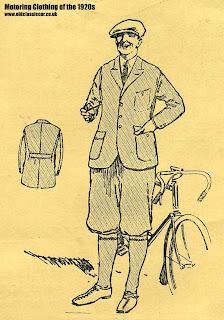We will work on men’s fashion in a few parts, starting with suits, then in a following post we will deal with accessories and hats.
1910-1919
So even though we previously said that the 1920’s were perhaps the inspiration for the Tweed Ride, we are going to step back a decade, because let’s face it, even in today’s media and internet driven age, many people are a little out of date.
The basic suit would consist of a coat, a waistcoat (also known as a vest) and a pair of trousers. Now it seems that sometimes all three would match, sometimes the coat and waistcoat paired with contrasting trousers, and sometimes you would match the coat and trousers and contrast the waistcoat. So the good news is this leaves you lots of options.
In this era the waistcoats were cut and buttoned lower and usually did not have a collar.
Trousers usually had a narrow, straight cut (not the baggy cut that would become popular towards the 1930’s) were ankle length, and often with the large cuff.
Shirts were often a sign of class. Since this is a pre washing machine era, collars were often not permanently attached onto the shirt. Working people often avoided solid white shirts to allow the wearer to hide dirt and grime and extend the use of shirt. Formal collars were often tall and stiff, but many pictures show soft rounded collars.
Of specific interest to our event, the Norfolk jacket was fashionable for outdoor activities like shooting or bike riding. Like non-white shirts, the sturdy tweed of the Norfolk jacket would hide dirt and wear well. This Jacket was often paired with knickerbocker/breeches and warm knee-length stockings. This combo would allow the pant leg to stay free of most mud and dirt, and out of the bicycle chain of a rider.
Early 1920's
For the most part men’s fashion was very similar to the previous years. The major changes being that the waist of jackets started to rise and belts started being more common than suspenders/braces. Pant remained narrow and straight, and there is often a visible space between the shoe and the upturned cuff. The style can also be viewed in WWI uniforms. You also see the buttons on jackets and waistcoats rising and collars become narrower.
1925-1929
Bernard-Hewitt & Co. Summer 1928 Apparel Sale Catalog
This is the era where trousers become baggy (sometimes referred to as "Oxford Bags").
In the world of jackets, waists return to normal, lapels widen and peak, and the cut becomes looser.
Vests are often double breasted and worn with single breasted jackets. (Double breasted jackets becoming popular in the 30's)
In the category of outdoor dress you start seeing short trousers (earlier years see “Plus Two’s” and later seeing “Plus Four’s” referring to the length in inches below the knee) as well as sweaters. Though many traditionalist still were the Norfolk jacket and tweed breech combo. (NOTE: Orvis and other sporting company’s still sell versions of this outfit)
The working class (i.e. laborers) often wore the same clothing though they often look a little more tattered, but it was not uncommon for men to be photographed without their jackets. Many of these pictures show men with or without a tie, sleeves rolled up, and with either just a vest on or just sporting their braces. There is a great amount of individuality you can make with this look. This is also a great look for a warm day.




I am a manufacturer ladies scarves and company ties who happen to come across your blog while searching for men's fashion blogs. Anyway, as a huge t-shirt lover, I strongly agree that t-shirts are truly one of the more versatile and affordable articles of fashion out there.
ReplyDelete